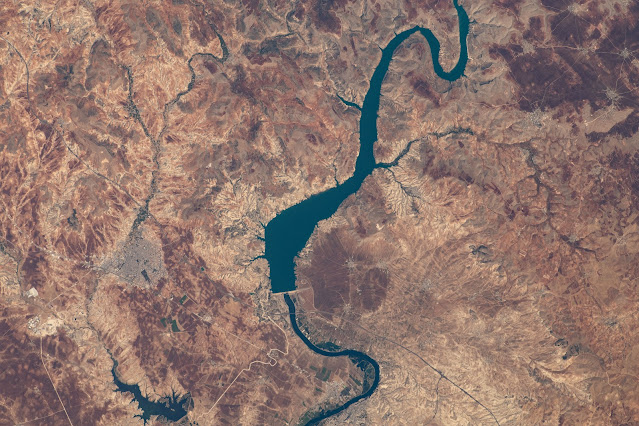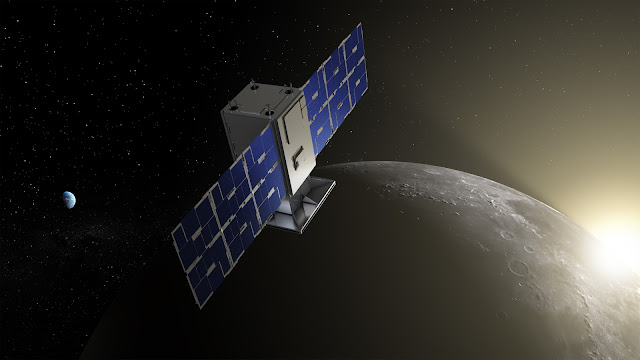NASA - Orion Crew Vehicle patch.
July 7, 2022
On NASA’s Artemis missions, a unique spacecraft will take flight. Orion, NASA’s newest spacecraft built for humans, is developed to be capable of sending astronauts to the Moon and is a key part of eventually sending them on to Mars.
An uncrewed Orion will be tested on Artemis I and travel 40,000 miles past the Moon, farther than any spacecraft built for humans has gone before. This mission will prepare for a crewed Artemis II mission and subsequent missions that will deliver astronauts to the surface of the Moon and to the lunar Gateway.

Image above: Artemis I Orion spacecraft inside the Operations and Checkout Building at NASA's Kennedy Space Center on Oct. 12, 2020. Image Credits: NASA/Rad Sinyak.
Orion’s crew and service module will carry astronauts to deep space. The launch abort system, positioned at the top of the spacecraft, is only used to pull the crew module and the astronauts inside it safely away from the rocket in the event of an emergency, and will be jettisoned after a successful launch and ascent atop the Space Launch System rocket.
Crew Module
Orion’s crew module, sometimes referred to as the capsule, capitalizes on more than 60 years of NASA space exploration experience. Built by main contractor Lockheed Martin, it can provide living space on missions for four astronauts for up to 21 days without docking to another spacecraft. Advances in technology for deep space travel such as life support, avionics, power systems, and state-of-the-art thermal protection will support the crew during launch, landing, and recovery.
Pressure vessel
The underlying structure of the crew module is called the pressure vessel. The pressure vessel consists of seven large aluminum alloy pieces that are joined together using friction-stir welding at NASA’s Michoud Assembly Facility in New Orleans. The process produces a strong, yet lightweight, airtight capsule.
Backshell
Covering the pressure vessel is the protective cover on the cone-shaped sides of the crew module known as the backshell, made up of 1,300 thermal protection system tiles. The tiles are made of a silica fiber material similar to those used for more than 30 years on the space shuttle, and will protect the spacecraft from both the cold of space and the extreme heat of re-entry.
Heat shield
The bottom of the capsule, which will experience the hottest temperatures as Orion returns to Earth, is covered by the world’s largest ablative heat shield, measuring 16.5 feet in diameter. The heat shield will protect Orion as it enters Earth’s atmosphere initially travelling about 25,000 mph and endure temperatures of nearly 5,000°F — about half as hot as the Sun.
The outer surface of the heat shield is made of blocks of a material called Avcoat, a reformulated version of the material used on the Apollo capsules. During descent, the Avcoat ablates, or burns off in a controlled fashion, transporting heat away from Orion.
Forward Bay Cover
The forward bay cover at the top of the crew module protects the top portion of the capsule and Orion’s parachutes during launch, orbital flight, and re-entry. It is covered with the same thermal protection tiles as the backshell. After the spacecraft re-enters Earth’s atmosphere, it is jettisoned at an altitude of approximately 23,000 feet to allow for deployment of the parachute system.

Image above: Technicians install three spacecraft adapter jettison fairings onto the Artemis I Orion spacecraft inside the Operations and Checkout Building at NASA's Kennedy Space Center on Oct. 12, 2020. The fairings are secured around the spacecraft, encapsulating the European Service Module to protect it from harsh environments as the spacecraft is propelled out of Earth’s atmosphere atop the Space Launch System (SLS) rocket. Image Credits: NASA/Rad Sinyak.
Reaction Control System Thrusters
The crew module has a propulsion system composed of 12 small engines called reaction control system thrusters. When the crew module separates from the service module for re-entry, the 12 thrusters are used to guide the crew module, ensure that it’s properly oriented with the heat shield facing downward, and keep the spacecraft stable during its descent.
Interior
Inside Orion, an aluminum structure of crisscrossing beams called the backbone assembly provides the floor structure where the crew seats will be attached and is where the crew stowage lockers will be located. Most of the equipment the crew will need to live in space on future missions will be stored here.
The four seats in the crew module are designed to accommodate nearly 99% of the human population. The seats are adjustable to ensure that astronauts can reach all the controls while in their pressure suits.
Crew Accommodations
A number of accommodations will help astronauts feel at home. Tanks and a dispenser provide drinking water and a simple way to rehydrate and warm food. Orion’s hygiene bay will have a new compact toilet, with a design that makes use in space easier for both men and women. A built-in exercise device provides both aerobic and strength training for astronauts. In case of a radiation event, such as a solar flare, crew members will shelter themselves in two large stowage lockers on the floor of the capsule, using the dense materials on board as shielding.
Displays and Controls
Astronauts will operate Orion using a sophisticated display and control system that uses advanced software to aid the crew. The crew will be able to command the spacecraft using just three display screens, about 60 physical switches, two rotational hand controllers, two translational hand controllers, and two cursor control devices. Electronic procedures are also programmed into the system to aid the crew in daily and emergency processes, saving the crew time and space and making large paper manuals of system operations obsolete.
Environmental Control and Life Support Systems
Environmental control and life support systems will make the crew module a habitable place for astronauts. A new regenerable system removes carbon dioxide and humidity and keeps the cabin air clean. The system also maintains the spacecraft’s temperature and pressure and detects if the internal environment becomes unsafe. Orion’s Crew Survival System spacesuits interface with life support to keep astronauts alive for up to six days to allow them to return home in the event of cabin depressurization.
Parachutes
The crew module houses Orion’s parachute system. The parachutes ensure a safe landing for astronauts returning to Earth at high speeds in the spacecraft. Earth’s atmosphere acting as a brake on Orion will initially slow the spacecraft down from about 25,000 mph to 325 mph. Then, the system of 11 parachutes must deploy in precise sequence to slow Orion to a relatively gentle 20 mph for splashdown in the Pacific Ocean.

Components of the Orion spacecraft. Image Credit: NASA
European Service Module
Below the crew module is Orion’s European Service Module, provided by ESA (European Space Agency) and built by lead contractor Airbus. The service module is the spacecraft’s powerhouse: supplying it with electricity, propulsion, thermal control, air, and water.
Propulsion
Orion’s service module provides propulsion capabilities that enable Orion to go around the Moon and back on its missions. The service module has 33 engines of various sizes. The main engine will provide major maneuvering capabilities while in space, including inserting Orion into distant retrograde orbit and leaving the orbit to return to Earth. The 24 reaction control thrusters are used to steer and control Orion while in orbit. Eight auxiliary engines are also used for translational maneuvers, essentially acting as a backup to the main engine. The propulsion system also has the ability to bring the crew home in a variety of emergency situations, including abort scenarios after the launch abort system has already been jettisoned.
Power
The service module’s electrical power system provides power for the entire Orion spacecraft. The system manages the power generated by the module’s four solar array wings, which provide enough electricity to power two three-bedroom homes. A total of 15,000 solar cells on the four arrays are used to convert light into electricity, and the arrays can turn to remain aligned with the Sun for maximum power.
Thermal Control
The thermal control system includes radiators and heat exchangers to keep the astronauts and equipment at a comfortable temperature. The thermal control system includes an active portion, which transfers the heat of the entire spacecraft to the service module radiators, and a passive portion, which protects the service module from internal and external thermal environments.
Consumable Storage
The consumable storage system of the service module provides potable water, nitrogen, and oxygen to the crew module, stored in tanks. Potable water is provided by the water delivery system, covering usable water needs of the crew for the duration of the mission. Oxygen and nitrogen are provided by the gas delivery system, with the amount of gases in each tank adjustable based on the mission profile.
Orion’s crew module will separate from the service module shortly before re-entering Earth’s atmosphere. The crew module is the only portion of Orion that will return to Earth at the end of each mission. On early flights, high-value crew module components such as avionics, and environmental control and life support systems will be reused, with plans to reuse more components on later missions.
Orion Components
Through Artemis missions, NASA will land the first woman and the first person of color on the Moon, paving the way for a long-term, sustainable lunar presence and serving as a steppingstone for future astronaut missions to Mars.
Learn more about the Orion spacecraft at: https://www.nasa.gov/orion/
Images (mentioned), Video, Text, Credits: NASA/Erika Peters.
Greetings, Orbiter.ch







































